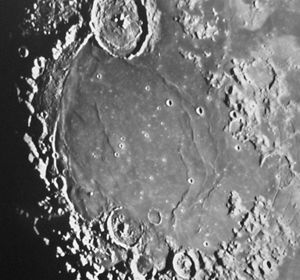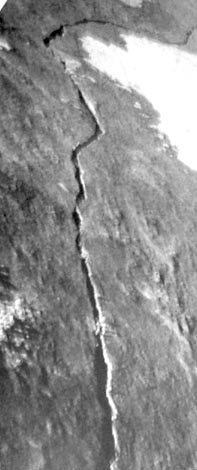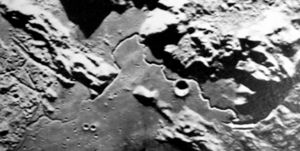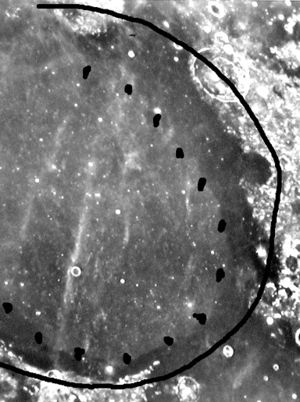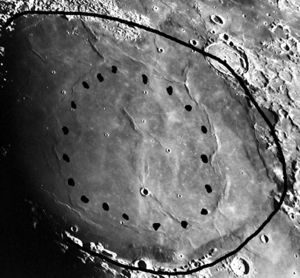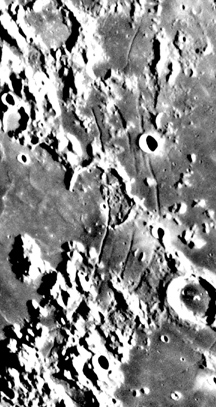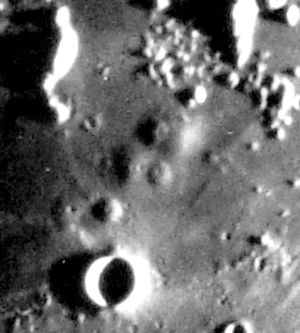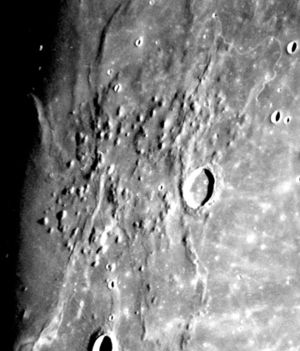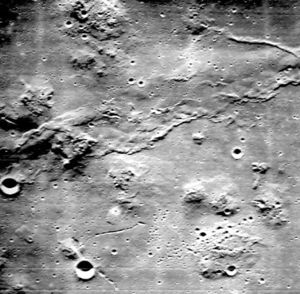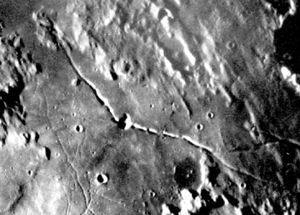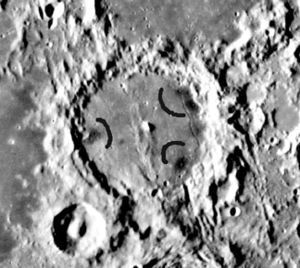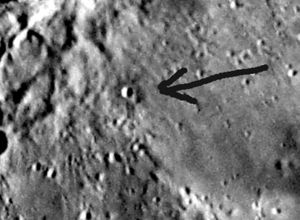Geologic Processes on the Moon/Volcanism
{Illustrations pending. This content is currently being adapted by Jarogers2001}
|
Volcanism is the next major geologic force on the moon. Radioactive elements (such as uranium, potassium, and thorium) reheated areas of the lower crust and upper mantle, creating a series of partial melts (once a melt erupts onto the surface, it is called ‘lava’). These melts were less dense than the surrounding rock, and so began rising toward the surface. The eruption of lava preferentially occurred in basins, and that for two main reasons: first, these massive impacts sent faults deep into the moon’s surface (tens of kilometers), providing conduits for the rising lava. Second, the mantle underneath the basins rose closer to the surface (isostatic compensation), making the path to the surface much shorter. Figure 1 is of the Humorum Basin, which has been flooded with ancient lunar lavas.
As lava erupted into the basins, it sometimes flowed long distances before finally ‘emplacing’. It could do this because lava on the moon has a low viscosity (it is very thin and runny). Indeed, when lava materials were melted on earth, it was shown to have the consistency of motor oil. This is because lunar lava is low in silicates (‘mafic’ lava). By contrast, earth’s ‘dome’ volcanoes contain lava of higher viscosity—making it more like toothpaste, so it can pile up higher (steeper slopes). It has higher viscosity because it is higher in silicates (‘felsic’ lava).
Lunar lavas generally erupted from fissures, which poured out and ponded in the geographically lower plains (fig 2: this image, from the Hawaiian Islands, shows the fissure left from a ‘fissure eruption’).
However when erupted onto an inclined surface, the lava could flow downhill and even create river-like channels from thermal erosion. On the moon, these formations are called ‘sinuous rilles’ (fig 3).
Some run up to several hundred kilometers before finally spilling their lava onto flatter surfaces.
This process of mare flooding resulted in large, flat lava sheets that covered the basins (cf. Fig 6, where a lava flow is marked by short, black lines).
Because the basins were concave in shape, lava was thicker in the center of the basin and thinner towards the edges. Now lava is denser (heavier) than the surrounding crustal rock, so it ‘compresses’ the bedrock underneath (a process generally called ‘subsidence’). The thicker areas in the center do this more than the thinner areas out at the edges. This changes the shape of the basin from a ‘flat’ surface to a very gently sloped ‘bowl’ shaped surface. This produces three unique formations.
First, it created unique, ‘target like’ surfaces. As the first lava flow subsided, the center would ‘sink’ and the outer areas remain raised. The next flows preferentially filled the lower central areas. Since each large eruptive event(s) had a slightly different composition, the ‘colors’ of the flow would also follow that pattern. This produced a ‘target like’ appearance to certain of the maria, with the outer bands representing the older flows, and the inner bands the younger ones (fig 4: the solid line shows the outer edge of the basin; between it and the dotted line, the older lava is still visible; newer lavas ponded in the center, covering all but the outer edge of the older lava).
One of the best examples of this is visible in Mare Serenitatis, and can be seen with telescopes of any size.
Second, lava subsidence produced stresses within the lava bed itself. As the lava in the center sank, it produced a compressive force where the thicker lava beds (on the sides of basin rings) met the thinner lava beds (on top of basin rings). These forces caused the lava to ‘buckle’ (perhaps due to blind thrust faulting) producing mare ridges over the basin rings (fig 5).
While there are several types of mare ridges, these are identified by forming a ring within the mare, and are often associated with small peaks that represent the highest points of the flooded basin ring (fig 6; the dark semicircles indicate peaks, while the short lines mark a lava flow).
Third, this process of subsidence put stresses on the lava bed and in the bedrock underneath. This rock was already deeply fractured from the basin impacts, and these new downward and inward stresses caused some of those faults to activate. They opened up creating a series of ‘grabens’ (grabens occur where two parallel faults are ‘pulled apart,’ with the center section falling down; this produces a flat bottomed valley). On the moon, this specific type of grabber is called an ‘arcuate rille’. These are only found around the edges of lava filled basins (fig 7).
The best examples are those around the Mare Humorum, and are visible in small telescopes on a steady night.
To this point we have discussed the usual schemes for lava filling of the basins, along with the formation of sinuous rilles, arcuate rilles, and mare ridges. Next we need to examine a few other features produced by the volcanic process.
The first of these are lunar volcanoes, which are called lunar ‘domes’ (not to be confused with volcanic domes on earth, that have steep inclines and different mineralogy). Lunar domes are smooth sided with low levels of incline. This is because lunar lava has such a low viscosity (as noted earlier). Most lunar domes are 5-20 km across, and often have a small pit crater at their summit (fig 8: this is a series of domes near crater Copernicus; note that several have central ‘pits’).
Note that a few lunar domes are steep sided, especially in the Marius Hills region, and this offer evidence for changes in the lava’s characteristics—such as cooling and lower rates of eruption. The Marius Hills region contains a large number of lunar domes (fig 9a: earth-based telescope view; fig 9b: Apollo spacecraft view).
The next features are called ‘dark mantling’ areas. These were formed by the process of ‘fire fountaining’. When lava is in the moon’s mantle, it is under considerable pressure. As it rises to the surface this pressure falls off, allowing gasses trapped in the lava to escape (called degassing). These gasses—thought to be carbon monoxide or carbon dioxide—act as propellants, shooting the lava high above the lunar surface. There the lava cools as dark, glassy beads. Upon falling back to the lunar surface, these beads produce large patches of ‘dark mantling'. The Apollo missions returned some of these glassy volcanic beads (the first ones identified were dubbed ‘orange glass’). Visually, these patches appear as large, very dark areas with low crater counts, and occur around basin edges. Some excellent example can be seen, even in small telescopes, around Mare Serenitatis.
Finally, there are three unusual lunar features produced by volcanism. The first of these are endogenous craters, such as Hyginus Rille. These are interpreted as volcanic in origin, and probably formed as collapse features (‘collapse pits’)(fig 10).
Only a return to the moon with further geologic work will fully resolve their origin. A second unusual feature occurs when a crater is flooded by lava, but after settling (subsidence), the crater rim became visible as a mare ridge (fig 11).
A number of these are visible on the lunar surface. A third unusual feature is the ‘dark halo’ crater. Two types of ‘dark halo’ craters occur, and both are associated with volcanic products. In the type found in Crater Alphonsus, the halos are associated with rilles, and likely represent places of volcanic fire fountaining on the moon (perhaps due to eruptive degassing)(fig 12: earth-based telescope view; fig 13: high resolution image from Ranger IX; note that the areas just around the craters don’t have visible craters, as they’ve been filled in by the volcanic products).
Thus it is no surprise that their halos are reminiscent of dark mantling materials. The other type of dark halo crater occur where a bright ejecta blanket covers an older lava flow. When a more recent impact occurs, it pierces the thin veneer of the bright ejecta and unearths the darker lava beneath it. The ejecta from this crater will include those darker materials (an example of this was Crater Shorty, which was visited by the Apollo missions). These can especially be seen in bright ejecta blankets of relatively young craters (fig 14; this one is in the ejecta of Copernicus).

